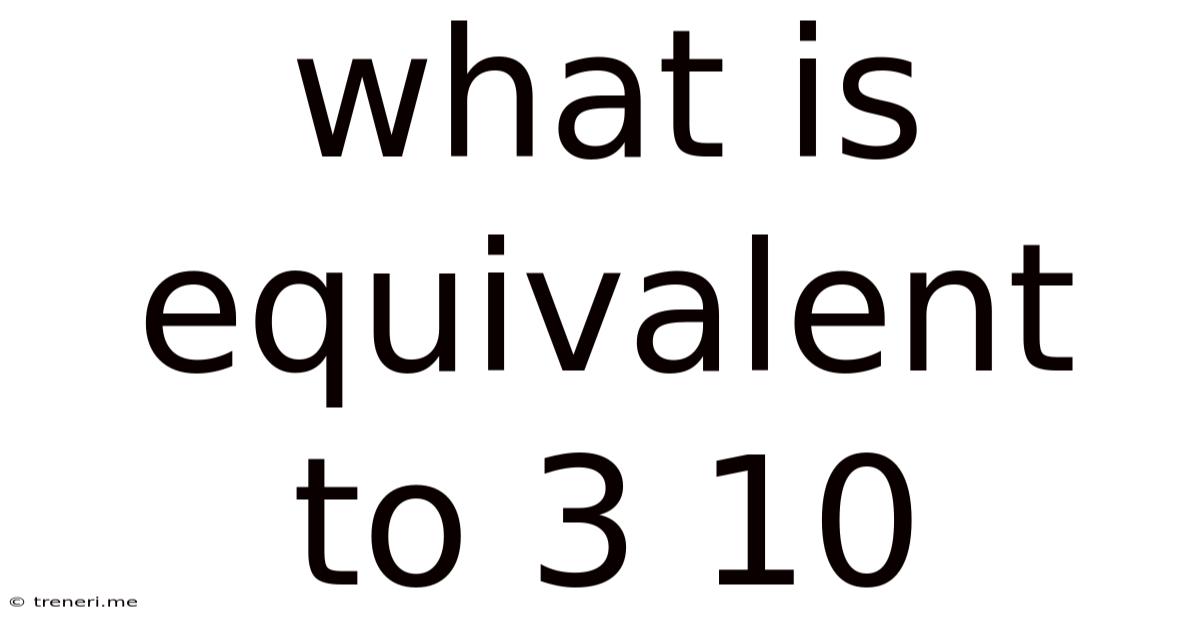What Is Equivalent To 3 10
Treneri
May 10, 2025 · 4 min read

Table of Contents
What is Equivalent to 3/10? Understanding Fractions, Decimals, and Percentages
The question, "What is equivalent to 3/10?" might seem simple at first glance. However, exploring this seemingly straightforward fraction opens the door to a deeper understanding of mathematical equivalency and how we represent numerical values in different forms. This article will delve into various equivalent representations of 3/10, exploring fractions, decimals, percentages, and even their applications in real-world scenarios. We will also look at how to find equivalent fractions and the importance of understanding these concepts in various fields.
Understanding the Basics: Fractions
A fraction represents a part of a whole. It consists of two numbers: the numerator (the top number) and the denominator (the bottom number). In the fraction 3/10, 3 is the numerator and 10 is the denominator. This signifies that we are considering 3 parts out of a total of 10 equal parts.
Converting 3/10 to a Decimal
Converting a fraction to a decimal is a straightforward process. We simply divide the numerator by the denominator. In this case:
3 ÷ 10 = 0.3
Therefore, 0.3 is the decimal equivalent of 3/10. This decimal representation provides a clear and concise way to express the fraction, particularly useful in calculations and comparisons.
Expressing 3/10 as a Percentage
A percentage is a way of expressing a fraction or decimal as a proportion of 100. To convert a decimal to a percentage, we multiply by 100 and add the "%" symbol. Since 3/10 is equivalent to 0.3:
0.3 x 100 = 30%
Therefore, 30% is the percentage equivalent of 3/10. Percentages are commonly used to represent proportions, often in contexts like discounts, interest rates, and statistical data.
Finding Equivalent Fractions
Equivalent fractions represent the same value, even though they look different. We can find an equivalent fraction by multiplying both the numerator and the denominator by the same number. For instance:
- Multiplying both the numerator and denominator of 3/10 by 2 gives us 6/20.
- Multiplying both by 3 gives us 9/30.
- Multiplying both by 4 gives us 12/40.
All these fractions – 6/20, 9/30, 12/40, etc. – are equivalent to 3/10. They represent the same proportion of the whole. This concept is crucial for simplifying fractions and performing arithmetic operations involving fractions. Simplifying a fraction involves finding the equivalent fraction with the smallest possible numerator and denominator. In this case, 3/10 is already in its simplest form, as 3 and 10 have no common factors other than 1.
Real-World Applications of 3/10 and its Equivalents
The fraction 3/10, and its decimal and percentage equivalents, appears frequently in various real-world contexts. Here are a few examples:
- Sales and Discounts: A 30% discount on an item means you pay 70% of the original price. This directly relates to the equivalent percentage of 3/10.
- Statistics and Probability: If there's a 30% chance of rain, it means the probability of rain is 3/10.
- Measurement and Proportion: If a recipe calls for 3/10 of a cup of sugar, you can easily measure this using the decimal equivalent (0.3 cups) or an appropriate measuring tool.
- Finance and Interest Rates: Interest rates are often expressed as percentages. An interest rate of 30% is directly equivalent to 3/10.
- Data Representation: In data analysis and visualization, 3/10 (or 30%) might represent a specific proportion of a dataset.
Further Exploration: Working with Fractions
Understanding equivalent fractions is essential for more complex mathematical operations. Here's a brief overview:
- Adding and Subtracting Fractions: To add or subtract fractions, they must have a common denominator. This often involves finding equivalent fractions with the same denominator.
- Multiplying Fractions: To multiply fractions, we simply multiply the numerators together and the denominators together.
- Dividing Fractions: To divide fractions, we invert the second fraction (reciprocal) and multiply.
The Importance of Understanding Equivalent Representations
The ability to easily convert between fractions, decimals, and percentages is a fundamental skill in mathematics and has wide-ranging applications in various fields, including:
- Science: Scientific measurements and calculations often involve fractions and decimals.
- Engineering: Engineers use fractions and decimals in designs and calculations.
- Finance: Financial calculations heavily rely on decimals and percentages.
- Computer Science: Computer programming frequently involves working with decimal numbers and representing proportions.
Conclusion: Mastering Equivalency
The simple fraction 3/10, while seemingly basic, provides a springboard to a more profound understanding of mathematical representations. The ability to seamlessly convert between fractions, decimals, and percentages is a valuable skill applicable across numerous disciplines. Mastering these conversions and understanding the concept of equivalent fractions equips you with the tools to tackle more complex mathematical challenges and confidently navigate various real-world scenarios requiring numerical analysis and interpretation. Remember, understanding the fundamental concepts empowers you to tackle more advanced applications and problem-solving.
Latest Posts
Latest Posts
-
How Many Square Feet Does A Gallon Of Stain Cover
May 10, 2025
-
How Old Are 1995 Babies In 2024
May 10, 2025
-
What Is 18 Out Of 30 As A Percentage
May 10, 2025
-
How Many Hours Is 7000 Minutes
May 10, 2025
-
How Much Water Should A Puppy Drink Each Day
May 10, 2025
Related Post
Thank you for visiting our website which covers about What Is Equivalent To 3 10 . We hope the information provided has been useful to you. Feel free to contact us if you have any questions or need further assistance. See you next time and don't miss to bookmark.